John McCarthy is a renaissance man. He is a surfer, author, freediver, adventure guide, innovator, educator and entrepreneur. He is also the subject of the beautifully shot documentary, Sea Change, from director Bruce Buttery, which Plastic Oceans International is pleased to have added to our roster of films – which can be viewed for free HERE.
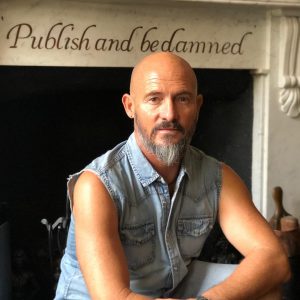
John McCarthy
This short movie tells the story of John’s efforts to make his life and love of surfing more sustainable because of his deep, life-long connection to the Ocean. We had the pleasure of working with John during our world-record-breaking Swim Against Plastic campaign on Easter Island, for which John served as navigator and safety officer for endurance swimmer, Sarah Ferguson. We recently sat down with him to talk about his life and the film.
PO: Why did you choose film as the medium to get your message across?
JM: I was approached by Bruce Buttery, who runs the Like Giants production company. A mutual friend had told him what I was doing with my quest to find more environmentally responsible surfboards. Bruce is a surfer himself, and he is also into conservation, so I think my story resonated with him. It just seemed like a logical thing for us to team up and document the effort and hopefully inspire other ocean users to do the same.
PO: How long have you been surfing?
JM: I’ve been surfing for forty years, and I surf most days. If I’m not surfing, then I’m swimming or diving. I’m in the ocean everyday and I never take it for granted. I feel blessed to have been able to spend my life doing what I love.
PO: Can you describe the moment you realized your passion for surfing was unsustainable? And tell us a bit about the sustainable boards that you now create.
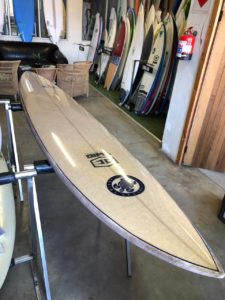
The beauty of John’s Ocean Child boards.
JM: I point my finger firmly at myself first! About ten years ago I was trying to figure out how many surfboards I’ve owned in my lifetime. At that point a fair guesstimate would have been at around 200, which would be a shipping container load, all toxic – both in their creation and long-term life, as they will never biodegrade, meaning they will be here long after I’m gone. I realised what an appalling environmental legacy that was to leave to my children. So I started experimenting with my own surfboards, using 100% recycled EPS foam for the core or blank, as we call them, and hemp, flax and bio – epoxy for the lamination. I’m proud to say that 10 years later they are really refined high performance surfboards with a fraction of the environmental footprint associated with their conventional toxic cousins. They are also more durable because the hemp/flax bio – epoxy combination is far stronger than conventional fibreglass and polyester resin. So they have less footprint and they last longer which is a double win!
PO: Tell us more about the historic Hawaiian surfboard we see you using in the film. Did you buy it or make it yourself?
JM: The Hawaiian surfboard you see in the film is called an Alaia. It is a simple carved piece of wood, but there is a consistent design principle that is highly effective and has been largely overlooked in recent times. It is by far the most environmentally responsible surfboard available because it is 100% biodegradable, but the drawback for most people is that it is very difficult to learn to ride. Hence most surfers avoid them. Once you learn how to ride it though it is a pure magic carpet ride. When I ride it, I’m able to draw different lines and commune with the wave in a completely different way. There’s a kind of intimacy with the wave that you can’t get from a conventional surfboard.
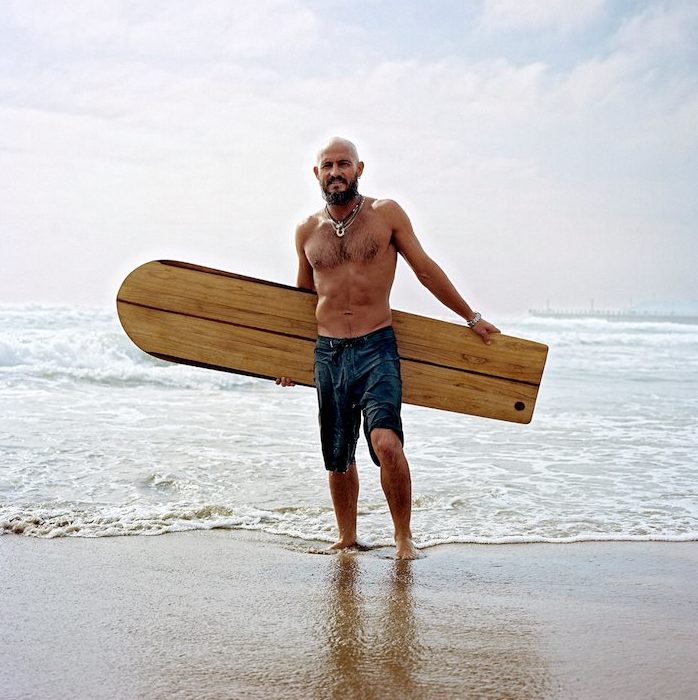
John with his prized Hawaiian Alaia surfboard.
PO: What is the significance of the poem at the beginning of the film?
JM: The poem at the beginning of the film shares the title of the film, Sea Change. Sea Change comes from Shakespeare’s The Tempest and refers to the alchemy or transformation of a drowned human body as it is taken over by corals and pearls and reclaimed by the ocean. ‘A Sea Change’ in modern times has also been used to describe a significant metamorphosis or evolution. I liked the double meaning and the relevance to my own journey from toxic consumer to environmental activist, so we named the film ‘Sea Change’ and then had my friend, Josie Field (check her out, she’s an amazing singer) read Shakespeare’s poem to start the film.
PO: It is mentioned in the film that you are having different conversations with your kids than your parents had with you. What is one thing you wish they had discussed with you?
JM: As a child we had this sense that the world was limitless, that we’d never run out of resources or space. Our focus was on survival and thriving and if there was a small (or not so small) environmental impact then so be it. As an adult we now realise that this is very much not the case. I see a far deeper environmental sensitivity in my children than I had when I was their age. This is great to see as progress but it also sucks for them as basically we’re leaving them with the problems we’ve created. I grew up in apartheid era South Africa. My parents were fairly liberal so most of our conversations were around politics and human rights and less about protecting the environment. We’d often go to the bush or the mountains but these wilderness excursions were more about adventure than a dawning mindfulness and realisation of how important it is to preserve these natural resources. I don’t have any regrets about the conversations I had with my parents, it was just a different time, with different issues. What is amazing to see though is how much more aware my children are than I was.
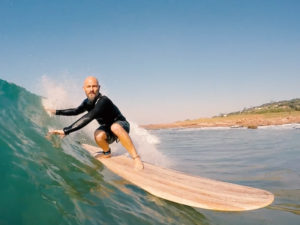
John catching a wave in Sea Change.
PO: What are the top 5 lessons you have learned during your time surfing and communing with the ocean?
JM: I’ve spent my whole life in and around the ocean and have learned so many things about myself and the world we live in during this time. Having said that I’m still learning, every time I go back into the ocean I learn something new. If I had to narrow it down to five things so far, I’d go with the following.
- The ocean teaches you humility. It is ever-changing and you need to be aware and respectful of that always. You can survive in very extreme conditions if you are humble and you can perish in very benign conditions if you are arrogant. Always be humble.
- Surfing as an act is both expressive and creative, it allows you to be in the moment. So many people spend so much time worrying about what could have been or what will happen. Most surfers understand that the experience of the present is a gift. I view it like sticking my finger into the light socket of nature.
- Surfing is a great metaphor for life. Waves don’t stay still for us when we ride them and neither does life. You are constantly altering your approach, you balance and your trim, just like in life!
- There are many different dances one can have with the ocean. View your equipment like you would the music you would dance to. You would never tango to the waltz. So broaden your definition of engagement then choose the right tool for the job.
- Give a wave… sometimes gifting someone else a great wave when it is your turn is just the right thing to do. Neither of you have anything to show for it afterwards but you’ll both feel good.

John freediving with a whale shark off Sodwana Bay. Photo: Ant Fox.
PO: In addition to surfing, you are also a world-class free diver. How does it compare to surfing, as far as how it connects you to the ocean?
JM: Freediving was something I only got into about 15 years ago. I was returning from a boating surf trip up in the bush, near the Mozambican border, when the skipper spotted a whale shark below the boat. He threw a snorkel and mask at me and told me to jump in. I was mesmerised by the creature and slowly swam down with it far deeper than I had ever ventured before. The moment I got back to the surface all I could think about was going back down as soon as I could. I started exploring more underwater and realised that the interactions I was having with marine wildlife while freediving were on a whole different level to what you could do when scuba diving. My path into freediving was, and is, all about learning more about the various sea creatures. I was never interested in the competitive side of freediving and I’m still not. What I have realised in more recent times is that freediving is not just a journey into the deep to visit my friends who live down there. Also the pressure of the water on your body is really good for you. It massages your muscles and pushes blood into places that it is difficult to get to. It also lowers your heart rate. The deeper you dive the lower your heart rate. I think of it like getting a great big hug from Mother Ocean. On the boat after freediving I always wondered why I wanted to hug everyone and pass on that positive energy. These days I realise there are profound health benefits to frequent immersion to depth. Its like you are having a meditation while connecting with yourself and nature all at the same time. For me, that represents a kind of nirvana or pure form. I’ve distilled my learning from both surfing and freediving into a course called ‘The SWIM FREE Confidence Underwater course’. This is aimed at helping other ocean users be safer while in the sea. Close to 4,000 people have done this course in the last 4 years. LEARN ABOUT JOHN’S ‘SWIM FREE’ HERE.
PO: Tell us a little bit about your company, Ocean Child.
JM: OCEAN CHILD currently has two components, innovation and immersion, and I’m hoping to add a third in the form of education soon. I produce and market my more environmentally responsible surfboards under the name, while also running surfing, yoga and freediving wilderness adventures in wilderness areas. More about the ethos of OCEAN CHILD can be found HERE.
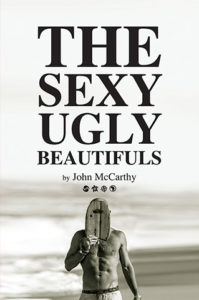
JM: The Sexy Ugly Beautifuls is a rock ’n’ roll collection of ocean infused adventures, so named after the colourful characters and exotic destinations I’ve discovered in my global quest to ride the perfect wave. The book has been really well received in South Africa (I’m into my third print edition). This has given me the confidence to start launching it all over the rest of the world. I recently returned from my London launch which to my great surprise and delight sold out. I am looking at lining up both Australia and the US next year.
CLICK HERE TO BUY THE SEXY UGLY BEAUTIFULS
PO: What’s next for John McCarthy?
JM: I’m looking forward to giving birth to the OCEAN CHILD ODYSSEY. This is a conservation initiative focused on educating our South African youth and visitors to our country about the environmental value of our coastline. I will navigate the length of our east coast from Khosi Bay to Cape Town using only natural means. Swimming, running, hiking, paddling, surfing, freediving, possibly some inshore sailing. The idea is not to travel much more than 1-2km off shore at most and to spend the bulk of the time in the intertidal zone. I will connect with local experts and points of interest along the way. The idea is to load a daily Instagram video as a blog which my kids and their friends can follow as well as other school kids from around the world. Visitors to SA could zoom in on specific Instagram blog posts that they are keen to explore and get the insights I share.
Stay tuned for updates on John’s amazing journey. We look forward to observing and participating in the amazing projects he has in store.
PLEASE DONATE TO PLASTIC OCEANS

Trackback: พารวยไปกับ ทีเด็ดบอลชุด
Trackback: rove brand
Trackback: check it out
Trackback: รับทำเว็บไซต์
Trackback: Caishen Wins
Trackback: สลากกินแบ่งรัฐบาล
Trackback: วิธีการสมัครและการใช้งานแพลตฟอร์ม TAI SHAN
Trackback: Доставка авто з США та Європи під ключ
Trackback: fox888
Trackback: ไฮเบย์
Trackback: นากาเว็บ สล็อต ค่ายเกมใหญ่ มาแรงอันดับ1
Trackback: บริหารสต็อกสินค้าแบบครบวงจร
Trackback: read article
Trackback: Werewolf\'s Hunt
Trackback: บาคาร่า All รวมค่ายบาคาร่าลิขสิทธิ์แท้
Trackback: ข้อดีของการเพิ่มยอดวิว